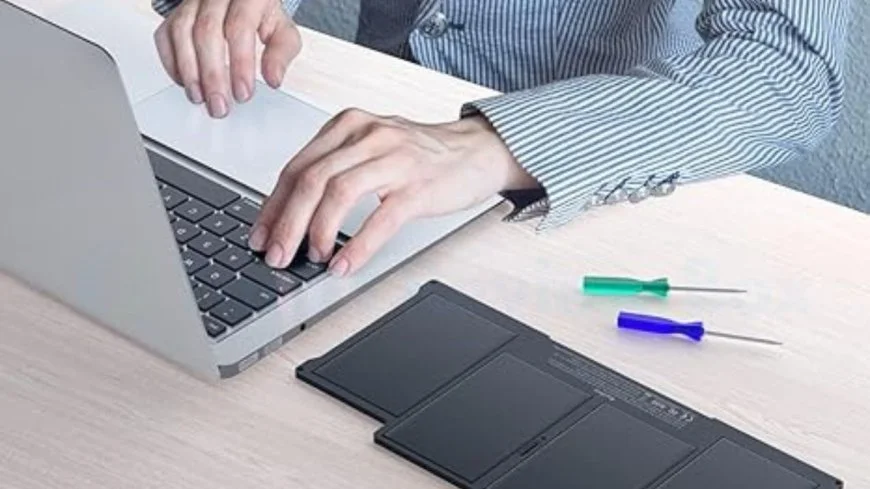How to Replace MacBook Battery: Easy Step-by-Step Guide
Learn how to replace your MacBook battery with our easy step-by-step guide. Find out your service options and costs for Mac repairs.

Looking to revitalize your MacBook? Say goodbye to sluggish performance and hello to seamless usage by replacing your MacBook battery. With our step-by-step guide, you can easily swap out the old battery for a new one, boosting your device's longevity and efficiency. No need to endure frustratingly short battery life when you can make this simple upgrade yourself.
Discover the cost-effective solution of replacing your MacBook battery at home, saving time and money compared to professional services. Unlock the potential of your MacBook with a fresh battery, ensuring uninterrupted productivity wherever you go. Stay tuned for expert tips and tricks on how to effortlessly replace your MacBook battery and breathe new life into your device.
Key Takeaways
- Regularly check your MacBook's battery health to recognize when a replacement is needed.
- Perform a simple battery check by observing any sudden drops in battery life or unusual behavior.
- Conduct a detailed battery assessment using system diagnostics or third-party apps for accurate information.
- Ensure you have the necessary materials such as a replacement battery, screwdrivers, and an anti-static mat.
- Prepare for the battery replacement by shutting down your MacBook, unplugging all cables, and working on a clean, static-free surface.
- Follow a step-by-step guide for replacing the battery to avoid damaging any components or causing safety hazards.
Recognizing Battery Replacement Needs
Signs to Watch For
If your Mac laptop battery is no longer holding a charge, consider checking for replacement needs. Look out for warning signs like sudden shutdowns or significantly reduced battery life. These are clear indicators that your battery might need replacing.
Age and Performance
An older Mac laptop may experience deteriorating battery performance over time. Consider replacement if you notice a significant drop in the battery's ability to hold a charge. This is common as laptops age and their batteries wear out.
Simple Battery Check
Battery Icon
Click on the battery icon located in the menu bar to perform a quick battery check. This action will provide you with essential information about your MacBook's battery status.
Health Status
Check the battery health status displayed after clicking on the battery icon. If it shows that service is required, it might be time to consider replacing the battery.
Cycle Count
Monitor the battery cycle count to evaluate its remaining lifespan. The cycle count indicates how many times your battery has been charged and discharged over its lifetime.
Performing a simple battery check on your MacBook is crucial to ensure its optimal performance and longevity. By regularly monitoring the battery health status and cycle count, you can proactively address any issues before they escalate. Remember, a healthy battery is essential for your MacBook to function efficiently.
Detailed Battery Assessment
System Information
To conduct a detailed battery assessment on your MacBook, utilize the System Information app. This tool provides comprehensive insights into your device's battery health.
Battery Condition
Review the battery condition to understand its current state. Check for any signs of wear and tear that might indicate the need for a replacement.
Cycle Count
Monitor the complete charge cycles of your MacBook battery. A high cycle count could suggest potential degradation and impact overall performance.
Full Charge Capacity
Assess the full charge capacity of the battery. This metric indicates how much charge the battery can hold compared to when it was new.
Analysis for Replacement
Analyze the gathered data from the System Information app to make an informed decision regarding a potential battery replacement. Look at factors such as cycle count, full charge capacity, and overall battery health information.
Materials Needed for Replacement
Essential Materials
To replace the MacBook battery, gather crucial materials such as a replacement battery, screwdriver set, and an anti-static mat. These items are essential for a successful battery replacement process.
Workspace Preparation
Create an ideal workspace by ensuring it is clean with ample lighting. A well-lit environment is crucial for accurately handling the delicate components during the replacement process.
Additional Tools
Consider any additional tools recommended by Apple to facilitate a smooth battery replacement procedure. Following Apple's recommendations can help prevent any potential issues during the replacement process.
Preparing for Battery Replacement
Backing Up Data
Before initiating the battery replacement process, it is crucial to back up all your data. This ensures that no important files or information are lost during the procedure.
Powering Off and Disconnecting
To begin the battery replacement on your MacBook, make sure to power off the laptop and disconnect all cables and accessories. This step prevents any potential damage to the device during the replacement process.
Grounding Yourself
It is essential to ground yourself before replacing the battery in your MacBook. Wear an anti-static wrist strap to prevent static discharge, which can damage sensitive components inside your laptop.
Taking these precautionary measures will help ensure a smooth and successful battery replacement process for your MacBook.
Step-by-Step Battery Replacement Guide
Removing Bottom Case
To begin the battery replacement process, carefully use the appropriate screwdriver to remove the bottom case of your MacBook. Ensure you keep track of the screws and store them in a safe place.
Once you have successfully removed the bottom case, you will gain access to the internal components of your MacBook, including the battery. This step is crucial as it sets the foundation for seamlessly replacing the battery.
Disconnecting Battery Connector
After removing the bottom case, locate the battery connector on your MacBook. Gently disconnect this connector to ensure that there is no power running through the device during the replacement process.
By disconnecting the battery connector, you are taking a necessary safety precaution to prevent any electrical mishaps or damage to your MacBook. Handling this step with care is essential for a successful battery replacement.
Installing New Battery
With the old battery safely disconnected and removed, it's time to install the new battery into your MacBook. Ensure that you align the new battery correctly with the designated slot to avoid any issues with compatibility or functionality.
Once you have securely installed the new battery, reconnect the battery connector to restore power to your MacBook. This step marks a significant milestone in completing the replacement process successfully.
Reassembling Your Mac Laptop
After installing and reconnecting the new battery, it's time to reassemble your Mac laptop by carefully putting back all components in their respective places. Make sure each part fits snugly and securely before proceeding.
As you reassemble your Mac laptop, pay close attention to detail and follow each step meticulously to ensure that everything is properly aligned and connected. Taking your time during this phase will result in a well-functioning device post-battery replacement.
Tips for Efficient and Safe Replacement
Battery Handling
When replacing the device's battery, it is crucial to handle it with care to prevent any damage. Avoid puncturing the battery as it can lead to hazardous situations. Make sure to follow the guidelines provided by Apple for a safe replacement process.
Safety Precautions
Adhering to the recommended safety precautions is essential for a secure battery replacement. These precautions are designed to protect both you and your device from any potential risks. Always prioritize safety by following these guidelines diligently.
Time Management
Taking your time during the replacement process is key to ensuring that each step is completed accurately. Rushing through the time-sensitive procedure can result in errors or damage to your device. Allocate sufficient time for each step to guarantee a successful replacement.
Post-Replacement Steps
Calibrate Battery
After replacing your MacBook battery, it's crucial to calibrate it for optimal performance. Start by fully charging the new battery, then completely discharging it. This process helps synchronize the battery with your device and enhances its longevity.
Calibrating the battery ensures that the system accurately reads the charge levels, preventing sudden shutdowns or inaccurate readings. By following this step, you can maintain a consistent and reliable power supply for your MacBook.
Monitor Performance
Once you've completed the replacement and calibration, it's essential to monitor the battery health regularly. Check the battery status on your Mac laptop to track its performance and ensure it is functioning correctly.
By keeping an eye on the battery health page, you can observe any changes in performance over time. This proactive approach allows you to address any issues promptly and maximize the lifespan of your new battery.
Power On and Check
After replacing the MacBook battery, power on your laptop to verify if the new battery is recognized by the system. Ensure that it is charging properly without any issues.
Checking if the new battery is being detected and charged correctly is crucial to guarantee uninterrupted usage of your MacBook. This step confirms that the replacement process was successful and that your device is ready for use.
Summary
You've learned how to recognize when your MacBook battery needs replacing, how to check its status, and the steps involved in replacing it. By following the detailed guide and using the right materials, you can efficiently and safely replace your battery. Remember to take precautions and follow the tips provided for a successful replacement process. Once you've completed the replacement, don't forget the post-replacement steps to ensure everything is functioning correctly. Now it's time to put your knowledge into action and give your MacBook a new lease on life with a fresh battery!
Frequently Asked Questions
How can I determine if my MacBook battery needs replacement?
To recognize if your MacBook battery needs replacement, look for signs like decreased battery life, frequent overheating, or sudden shutdowns even at a high charge. If you notice these issues, it's advisable to consider replacing the battery.
What materials do I need for replacing my MacBook battery?
You will typically require a compatible replacement battery for your MacBook model, along with screwdrivers (Phillips and Tri-wing), spudger tool, and an anti-static mat. Having a clean workspace with good lighting is essential for a successful battery replacement process.
Is it safe to replace the MacBook battery on my own?
Replacing the MacBook battery yourself can be safe if you follow proper guidelines and take necessary precautions. Ensure you have the correct tools, follow a reliable guide specific to your MacBook model, and work in an organized manner to prevent any damage during the replacement process.
How long does it usually take to replace a MacBook battery?
The time taken to replace a MacBook battery can vary depending on your familiarity with such tasks and the complexity of your MacBook model. On average, it may take around 30 minutes to an hour for someone following the steps carefully for the first time.
Are there any post-replacement steps I should follow after replacing my MacBook battery?
After replacing your MacBook battery, ensure you calibrate it by fully charging and discharging it once. This helps in resetting the battery indicator and maximizing its performance. Monitor the new battery's behavior to ensure it functions optimally in your device.
What's Your Reaction?







































![MacBook Pro M5: All the features and specs you need to know [LEAKS REVEALED]](https://tomsreviewbox.com/uploads/images/202502/image_430x256_67bd6d7cd7562.jpg)


























